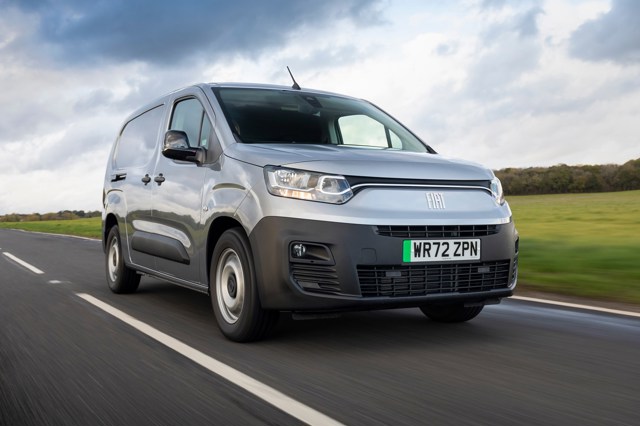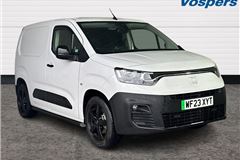Fiat e-Doblo Review 2024
Fiat e-Doblo At A Glance
Fiat’s electric powered version of the Doblo is one of four vans offered by the Stellantis Group that shares the same basic bodywork and is one of three electric vans offered by the company’s commercial vehicle arm, Fiat Professional. But is it worth a look? Read our comprehensive Fiat e-Doblo review to find out.
The latest version of the Fiat Doblo shares its bodywork with the Peugeot e-Partner, Citroen e-Berlingo and Vauxhall Combo Electric, as well as joint venture partner Toyota’s Proace.
In electric form it delivers a 171-mile range (based on the WLTP test cycle) and a payload of up to 800kg, with between 3.3 and 3.9 cubic metres of load space. Power comes from a
51kWh battery pack and an electric motor offering up to 136PS depending on driving mode, of which there are three – Eco, Normal and Power.
There are two body lengths, a crew cab option in the larger of the two and two trim levels, known as Standard and Primo.
The Fiat e-Doblo can also use CCS rapid charging with a maximum speed of 100kW - allowing a 0-80% charge in around 30 minutes on a 100Kw charger. The onboard charger, meanwhile, is a 7Kw unit compatible with most home sockets, but a three-phase compatible 11kW charger is offered an option for larger business users. A standard at-home charge will take about 7.5 hours.
The standard warranty runs for three years or 100,000 miles, while the battery comes with an eight-year/100,000-mile warranty. An extended warranty is available under Fiat’s 555 Peace of Mind deal. This brings you five years of warranty, five years of servicing and five years of roadside assistance. It is an optional extra, though, which means it is not as appealing as Toyota’s comprehensive 10-year warranty on what is essentially the same van.
Driving the Fiat e-Doblo
The electric motor and battery on the Fiat e-Doblo feature proven technology used on other models in the Stellantis Group including a number of passenger cars, and offer a refined, relaxed and surprisingly lively driving experience, with instant torque from the electric motor.
There are three different driving modes: Eco, Normal and Power. The headline 171-mile range only applies in 81PS Eco mode. Expect closer to 130 miles in Normal mode, where the power output is 109PS and you’ll only get the full 136PS in Power mode, which drinks battery power but is useful for merging with fast traffic via slip roads. Bear in mind that the default drive mode is Normal, so if you want to maximise your electric range then you need to manually select Eco each time you switch it on and off.
Safety-wise, there is a number of driver assistance features, including lane departure warning, blind spot assist, hill start assist, active safety-assisted braking and hill descent control. Primo models also get a reversing camera and blind spot assistance.
The Fiat e-Doblo is a relaxing van to drive with good all-round visibility and, as with all electric vehicles the initial power delivery is quite sharp, so around town the Eco mode is totally up to the job – you’ll only need more powerful modes for bursts of dual carriageway or accelerating out of tight junctions.
The ride is supple and soaks up poor surfaces well and the steering is light and easy to judge.
The only real downside is the limited range in higher power modes, which makes it more suited to short-distance and local operators. For many it’ll be ideal as it is, but those needing a longer range may prefer to wait for the next generation of battery technology that Stellantis is currently developing. It’s also far from cheap, but the fact it remains eligible for the government’s £5000 electric van grant will help a long way in this regard.
Fiat e-Doblo interior
There are two body length options on the Fiat e-Doblo – the standard L1 and the Maxi L2. The shorter of the two is 4.4 metres long and the larger is 4.75 metres long, with a crew van formation with a folding rear bench seat offered in the longer of the two.
The shorter body comes with a single sliding side-loading door and barn-style double doors at the back. In Maxi format, you get a second sliding door and in non-Crew Van format it will swallow two Euro pallets, while the maximum loading width is 1630mm. Space between the wheel arches is 1229mm. The payload is 803kg for the L1 model and 751kg for the Maxi, which weighs more to start with and comes with twin side loading doors as standard. The crew cab is rated at 721kg payload and each has a 750kg towing weight.
There are two trim levels – Standard or Primo. The Standard is the entry level and gets air con, cruise control, a five-inch touchscreen, a full-size bulkhead and rear parking sensors, with unpainted bumpers and steel wheels.
Go for the Primo and you get an eight-inch touchscreen with Apple CarPlay and Android Auto functions, body-coloured bumpers and mirrors and plusher trim – it’s a good-looking van, more suited to SMEs and sole traders who want to make a good impression, and the sharper front-end styling of the Fiat compared with its sister vans may well be enough to swing it for some.
The Primo trim is also offered with the option of a split twin front passenger seat, the middle half of which folds flat to allow longer narrow items to be carried through a loading hatch and can also be used as a desk or a work table.
The seating position is extremely comfortable and the interior trim and layout are comfortable and very much car-like in their appearance. A secure hidden storage cubby under the passenger seat is ideal for laptops or small power tools, while the large door pockets, dash-top cubby and capacious glove compartment are also extremely useful features.









 Good to drive, practical load bay, smart interior
Good to drive, practical load bay, smart interior
 Fairly expensive, limited range won’t work for everyone
Fairly expensive, limited range won’t work for everyone


